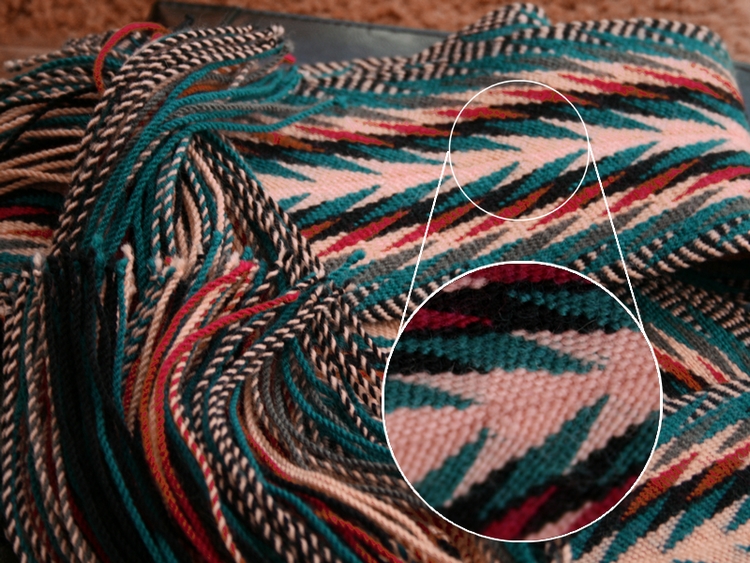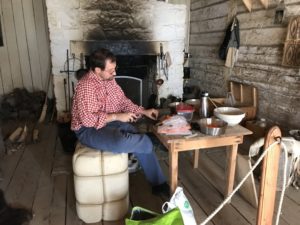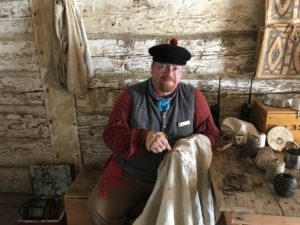One of the luxuries of the summer was lots of demonstrations going on at Fort Union Trading Post National Historic Site. With the addition of seasonal staff and Tom and me as volunteers, we had plenty of people to work each day and a couple of folks could do demonstrations. After the Visitors Center and Trade House are covered, the remainder of the staff are demonstrating.
Most of the rangers have less interesting demonstrations. Ranger Leif has been making sails for keelboats, which he can talk about but watching somebody do handstitching isn’t all that interesting. Ranger Ian made moccasins and then made a small canvas bag. Again, handstitiching isn’t all that interesting to watch. Ranger Kristin did some beading which looked very nice but is difficult to talk to visitors about. Ranger Bess doesn’t have a demonstration so she doesn’t get scheduled for demo days.
Tom does blacksmithing one or two days a week and is just as fascinating as ever. If you have never seen his blacksmithing demonstration, you might not understand. People stand around and listen to him for 30 minutes at a time, asking questions and listening as he shares information. If they have watched a while and there aren’t too many people around, he makes a hook and gives it to them to take home. People love that. I often have people come up to me and tell me “The blacksmith made me a hook!”

In addition to his blacksmithing, Tom has been learning about being a cooper from Ranger Karl. We worked with Ranger Karl Koster at Grand Portage and he knows everything about woodworking of any kind in the 18th and 19th centuries. He can talk for hours about coopering. I lose interest after 15 minutes or so, but Tom has been soaking it all in. By the end of our time here he hopes to know enough to make buckets at Fort Frederica.

People love to watch Tom and Karl work on a bucket or barrel and listen to the talk that goes with it. The biggest question is always “Will it leak?” And the usual answer, with a well-made bucket, is “No.” Tom has spent most his time making staves and hooks. He also knows how to fit the bottom of a bucket on. I’m sure by the end of September he will be an expert.

My demonstration is weaving sashes. There were no Euro-American women at Fort Union Trading Post so there were no looms. All the fabric people wanted was shipped in through St. Louis after being woven in factories in New England, Europe, and Great Britain. The Native American women here at the fort made sashes by finger-weaving. In finger-weaving you hang yarns up and use the warp yarns as weft, moving one string at a time to the front or back. You can see a video that demonstrates finger-weaving here. It would typically take a Native American woman 300 hours to make a sash by finger-weaving.
My goal was to make sashes that looked like Metis sashes. Metis sashes are the sashes worn by the children of fur-traders and Native American women. Metis means mixed blood in French. The sashes are a proud part of the Metis heritage and the traditional Metis sash is finger-woven.

I have been practicing finger-weaving all summer but I am only up to lesson 6 in the finger-weaving book and the widest thing I’ve made has 36 strings and two parts. Traditional sashes have 160 to 300 strings and eight to 20 parts. The stuff that I’m weaving doesn’t look bad, but I’m definitely not ready to do a finger-woven sash.

I had hoped to be able to weave sashes on my loom that look like Metis sashes. Unfortunately, nothing looks like finger-weaving except finger-weaving. So, when I am demonstrating I tell people that a traditional sash takes 300 hours to make and so I’m cheating.

People still enjoy my demonstrations on weaving sashes. I have now finished four sashes and I have three of them out for people to see. I also have my finger-weaving examples out. Kids, especially, love learning how a loom works. If they are older and have been patiently listening, I let them try weaving a few rows. I have the younger kids help me wind a bobbin with my bobbin winder from the Great Lakes Fiber Show.
All of the rangers wear sashes with their historical clothing, so I am planning on giving all the sashes to Fort Union Trading Post when I am done. I have lots of people ask if I am selling them, but I tell them no. The closest I’ve come to saying yes is a Metis woman who was in a couple of weeks ago and just loved one of the sashes. Of course, I would be more likely to give it to someone than to sell it.

I am currently weaving sashes 3 and 4 of plain red. Two of the rangers asked for plain red sashes and I actually think they look better than the patterned ones. Maybe I got too fancy with the pattern. The patterned sashes were 22 steps and I lost track of where I was in the pattern a lot. Hard to keep track of 22 steps when you are talking to people. The red sashes only have a four step pattern and it is easy to tell where I am with that. Also, it is easier to let a youngster help me out.

All of us enjoy doing our demonstrations. Unfortunately we are now down three staff people. Two returned to school and one of our seasonal rangers left for a full-time NPS job. Consequently, instead of three demonstrations on a given day, only one of us will be able to be out demonstrating. Because demonstrating is more like playing than working, we all look forward to those days.



One comment